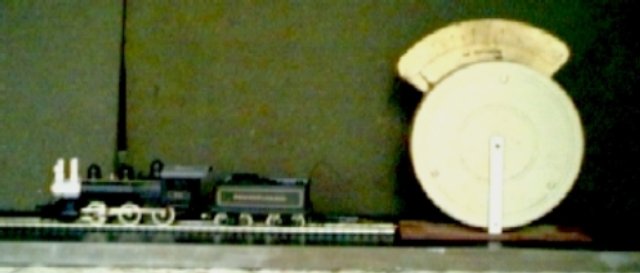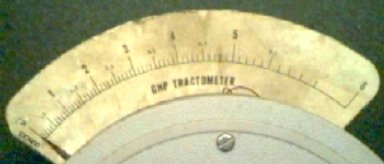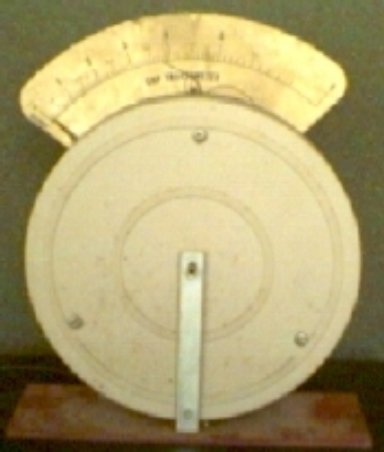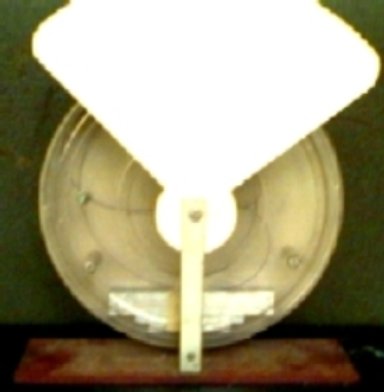Each month we can read loco drawbar reports with fancy meaningless graphs on how well those of the big advertisers can pull. These are compared to some imaginary "average" of recently tested locos. Many very important factors are judiciously omitted. How was the pull measured? How long is recent? Necessary for verification of factor of adhesion, what is the weight on drivers? Each review raises many more doubts and questions than answers. With some easily made devices, we can make our own measurements.
In the early days, I used a PULLEY DRAWBAR FORCE MEASURER. A string was coupled to a loco and run above the track over a pulley then down to a container suspended from it, into which weights could be loaded. The amount of weight at driver spin equals the starting tractive effort. If the starting guess were too light, there was not enough time to load sufficient weight, resulting in several trials. If it were too heavy, it would drag the loco backward. For the fastidious ballbearing pulleys are recommended.
While developing the motor dynamometer, inexpensive Ohaus spring balances were found and tried with the pulley arrangement above, by routing the string upward to the hanging scale. Results were excellent.
The sloping fixture or inclined grade requires adjustments with multiple runs along with calibration and computation.
When we picked up the GHP line, the first thing on the test agenda was the Tractometer. That is what the manufacturer called it. Actually it is a dynamometer or draw bar pull measurer yielding the force in ounces. Yes, weight, dynes, ounces, newtons and pounds are all technically forces. This should indicate the number of standard cars a loco can pull; if you can ever find a standard car, the topic of extensive debate and wild claims. However the results can compare locos with each other anywhere as long as the test conditions are standard and obtainable. I have settled on a level, squeaky clean, length of nicklesilver track and a standard full wave rheostat powerpack, which any one can obtain.

Note: Adjust brightness and contrast for optimum viewing.
Tractometer
On examination the parts seemed rather crude, but the instructions were more than adequate. After assembly comparison tests, using the weight and pulley contraption, the calibration proved to be excellent. The concept is based on elementary torque principles. A string wrapped half way around the can applies a force at the bottom rim which lifts a weight inside by turning the can. The horizontal distance from the center of mass to the axle determines the force needed to lift it.
The basic test consists of placing a loco on a track and having it pull against an ever increasing force until the drivers just start to slip. The measured force is the maximum drawbar pull under these conditions. Repeating the test once or twice may confirm the unexpected, but more is superfluous.
CAVEAT: Prolonged slipping will polish both rail and tires reducing adhesion and in extreme cases wear through any plating. Normally, with unmodified, commercial, run-in locos, there is little danger from overheated motors.

Tracking is within +/- 0.01 oz across the 6 oz full scale deflection, sinusoidal scale. Since one group has avowed that 1 oz drawbar pull = 14.5 "standard", 6 inch cars; one car requires 0.069 oz pull. The maximum error is less than 1/3 car per ounce. The scale is some what discolored and tattered because in his haste to play with his new toy, some idiot forgot to over-spray it.
What appears to be a 5 inch plastic film or tape can is screwed together with spacers to prevent bottoming and provide a groove for the string. Flared end tubing through the center provides an axle. This is supported by two holes in a U shaped bracket screwed to the plastic base. The scale is glued to a form cut sheet of styrene, screw mounted on an L shaped bracket, to permit zeroing.

Inside 9 lead printer slugs are mounted adjacent to the rim wall and directly opposite, there is an entry hole to permit tying the string to one of the spacers.

On the rear a jutting screw acts as a stop and a Z bent, brass pointer is glued at the rim. The base is anchored to an aluminum channel track support. A small swivel snap connector is tied at sting end to permit coupler interchange or clipping to a frame.

A small strap is added to a Kadee #4 coupler to prevent fall through.
FACTORS EFFECTING DRAWBAR PULL
Although data has been collected on well over 250 HO locos plus a few N, and stored in Sbase 4 (Superbase) Professional on my AMIGA, only a few noteworthy data will be included here. Deriving exact coefficient of friction from adhesion is very difficult, based on the number of variables such as weight distribution, balance, tire contour and others. Therefore the following must be very general in nature.
First, tread material is probably the most important. Athearn 's sintered steel ranks highest, followed by steel, aluminum and brass, with nickel and chrome plating much lower. The trade off for pretty tires and purported better pickup is loss of adhesion. Traction tires vary in material and change with age, wear and oil absorption that no general conclusion can be drawn, except I personally detest them as a cheap substitute for proper weighting and tire material.
Track material is next with WWII steel rail highest followed not too closely by brass, if you live in a desert or are in scales larger than HO. Nicklesilver follows closely behind brass and is the trade off for humid areas, since its oxide is a much better conductor than the others. Stainless steel has not been tested, but from other experiences, it should prove slippery.
RP-25 tire contour has considerably less adhesion than older ones.
Pulse power reduces adhesion noticeably due to the intermittent application of force. The sharper the pulses, the greater the reduction in adhesion. It is difficult to quantize the effects because of variables like motor response, gear backlash and transmission material resiliency.
With a given coefficient of friction, weight on drivers controls adhesion. Simply, more weight = more adhesion. WEIGHTING LOCOS for optimum performance is an art which requires some study.
The only commercial locos that approach or exceed the 6 oz limit have lead boilers or shells, non-plated tires of older contours and weights on drivers over about 28 oz for a factor of adhesion (A) of 4.67-5. Ie: Penn-Line older K-4, L-1, I-1, T-1; Varney consolidation and larger locos and larger Cary conversions. Athearn's heavier diesels with sinterred steel wheels approach 5 oz and A ≈ 4.8, while Mantua's older zamac boiler Pacific and Mikado are in the 3.5 oz range and a ≈ 5.2. Rivarrossi's Y6b and U25c with traction tires were close to 6 oz when new, but after a few hours running under load on standard layouts, dropped below 4 oz. Some plated tires exceed a very slippery A = 5.5.
Unmodified brass locos cover a wide range. Some of the older, heavy Akane, Gem and PFM had good adhesion, but most of the later models are only fair due to less weight and shinier tires with RP25 contour.
The most noticeable relationship is traction reduces as tread polish or shine increases. Thus the electrical noise requiements of DCC are diametrically opposed to better traction. There are probably many other observations that were overlooked. Those presented will be amended and others added as they come to mind. More technical information is under development in companion articles.
BACK TO GRADES
BACK TO ESOTERIC TEST EQUIPMENT
BACK TO MEASURING INDEX
BACK TO TIPS ON TESTING
